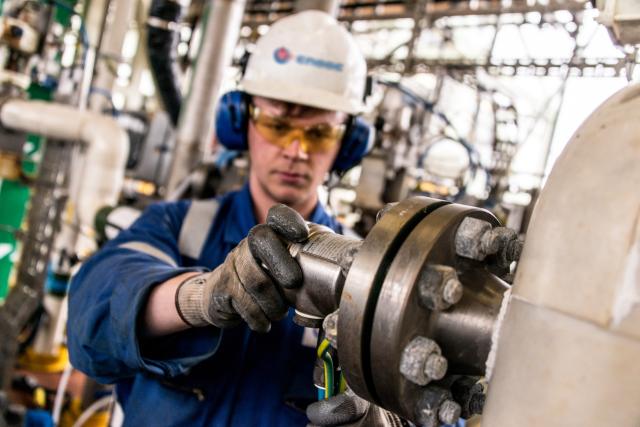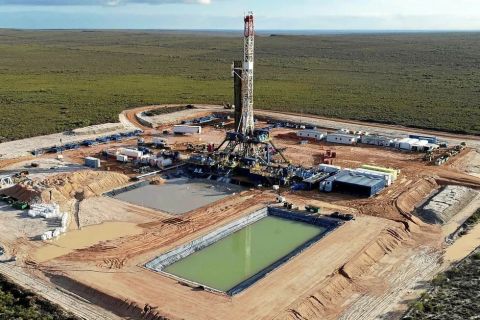
As the industry embraces digitalization and the energy transition, about 10,000 recruits are expected to be for roles that do not yet exist. (Source: CNOOC International)
Five years on from the downturn, which saw nearly half a million oil and gas jobs lost worldwide, the digital transformation, a rapidly changing political and economic landscape, and the energy transition are transforming the roles and skills needed in the sector.
While some companies continue to experience pressures, others are now bolstering their employee numbers. This move from redundancy to recruitment is buoyed by increasing investment, reduced costs and improved efficiencies finally taking hold. For example, the west of Shetland area has seen the greatest offshore development activity since 2014, and staff numbers have more than doubled in that period. As activity picks up and the industry’s galvanized response to a “lower for life” ethos bears fruit, job numbers across the sector could rise for the first time in four years.
Back to work
This growing optimism is being reinforced by higher levels of investment, which has seen the recent approval of several new developments such as Shell’s Penguins and Hurricane Energy’s Lancaster projects. Likewise, Premier Oil’s Sea Lion development and Equinor’s Rosebank, which was recently acquired from Chevron, is at the planning stage. More spending also is predicted to be pumped into extending field life for existing platforms and floaters offshore.
It is hoped that anticipated new greenfield projects could unlock about $4.35 billion of new investment over time, providing a much-needed boost throughout the supply chain.
There is also a raft of mergers and acquisitions activity on the U.K. Continental Shelf (UKCS), which is anticipated to stimulate fresh investment in brownfield projects as new owners look to increase and extend production from their North Sea assets. Examples include Chrysaor’s $3 billion asset package acquisition from Shell, EnQuest’s deal to increase equity and become operator of the Magnus Field and associated infrastructure, and Total’s purchase of Maersk Oil.
This is good news for the U.K. supply chain, where every $1 million spent by the industry on capital projects typically provides employment for 12 people across the supply chain (indirect jobs) and another eight (induced jobs) within the wider economy.
Vision 2035 is the industry’s shared ambition for the future and is being coordinated by Oil & Gas UK. The Vision 2035 Task Group of industry leaders also will develop a strategic road map to encourage transparency as to the way forward. Essentially, Vision 2035 aims to add a generation of productive life to the basin while also looking to provide more support to the supply chain to extend its global market share.
The recent OPITO UKCS Workforce Dynamics Review showed that if the sector achieves the ambitions set out in Vision 2035, 40,000 people will need to be recruited over the next two decades. As the industry embraces digitalization and the energy transition, about 10,000 of those are expected to be in roles that don’t even exist yet.
To put this in context and demonstrate the advance of the digital era, 30 years ago there were no desktop PCs or laptops in any oil and gas company. All written engineering job packs, for example, were prepared by an in-house word processing pool. Now, looking to the future, the advance of data science, artificial intelligence and machine learning requires totally new skills and mindset to drive forward a more dynamic destiny for the industry.
Stability and sustainability
Latest estimates show that the U.K. oil and gas sector supports about 283,000 jobs through direct employment, indirect employment and jobs that are induced by its wider economic contribution.
By 2035 the UKCS should still be producing 1 MMboe and, therefore, be a robust and resilient sector supporting jobs and careers, security of energy supply as well as advancing innovation.
For instance, the U.K. government figures estimate that in the 2030s and beyond, oil and gas will still support two-thirds of the country’s energy demand. Fossil fuels will continue to have a positive role to play in the wider energy mix as the transition moves the U.K. to a lower carbon economy.
While a return to hiring is a welcome sign of industry confidence, there will be clear challenges associated with growing headcount after a period of significant cuts and stagnant growth.
Identity overhaul
Shifting societal expectations will influence how the industry moves forward and its attractiveness to current and future generations. From its approach to diversity and inclusion as well as to new technological and behavioral ways of working, the industry is under the microscope as it cautiously prepares for an upturn.
According to a report from EY, the oil and gas industry has a negative perception among young people. It found that those questioned were disincentivized to pursue careers in the sector over concerns about the longevity of the industry and a perceived notion that the sector is “harmful” to society. According to the survey, 62% of those questioned from Generation Z (ages 16-19) fi nd the prospect of a career in oil and gas “unappealing,” while 44% of millennials (ages 20-35) said careers in the industry do not appeal to them.
In areas such as cybersecurity, automation and data science, the industry faces a recruitment battle with other more attractive sectors, such as the automotive and aerospace arenas. Many engineers are also drawn to greener energy industries. Therefore, there is a need for leaders to focus and promote how the industry economically, environmentally and safely tackles the technology challenges presented to meet energy demand.
For the first time at SPE Offshore Europe 2019, the keynote program session “Securing Generation 2035” will offer delegates insight into how to grasp the nettle of these issues and openly discuss ways to transform the industry’s image to make the most of the talent pool available. Graduates and apprentices will share their experiences with academics, leaders and innovators. The advance of technology and innovation continues to be a priority area for the oil and gas industry and will inevitably result in changes to the workforce. For example, increased digitalization may create remote working opportunities. As such, it will be vital for the industry to understand the existing and future workforce and to proactively develop the skills required to harness the opportunities afforded by these new innovations. A compelling career choice The oil and gas industry is changing and becoming more dynamic. To retain and recruit the workforce of the future, diversity and inclusion will play a crucial role in helping reposition the sector as an appealing and compelling career choice. This applies to championing talent across all levels within oil and gas businesses as well as those looking outside when considering employment.
As a whole, the industry must take pride in and strengthen its new, more cost-effective and environmentally sensitive ways of working and the collaborative approaches that are being forged across the industry. This can challenge the boom and bust approach of the industry and overturn other negative and potentially damaging perceptions.
However, vigilance and resilience should be the cornerstones of activity moving forward, and the industry must continue to hold its nerve and continue to focus on
effi ciency improvements, cost management and better business practices that have been put in place to enable a more sustainable industry where people can thrive.
References available. Contact Ariana Hurtado at ahurtado@hartenergy.com for more information.
_________________________________________________________________________________________________
Have a story idea for Industry Pulse? This feature looks at big-picture trends that are likely to affect the upstream oil and gas industry. Submit story ideas to Group Managing Editor Jo Ann Davy at jdavy@hartenergy.com.
Recommended Reading
Brett: Oil M&A Outlook is Strong, Even With Bifurcation in Valuations
2024-04-18 - Valuations across major basins are experiencing a very divergent bifurcation as value rushes back toward high-quality undeveloped properties.
Marketed: BKV Chelsea 214 Well Package in Marcellus Shale
2024-04-18 - BKV Chelsea has retained EnergyNet for the sale of a 214 non-operated well package in Bradford, Lycoming, Sullivan, Susquehanna, Tioga and Wyoming counties, Pennsylvania.
Triangle Energy, JV Set to Drill in North Perth Basin
2024-04-18 - The Booth-1 prospect is planned to be the first well in the joint venture’s —Triangle Energy, Strike Energy and New Zealand Oil and Gas — upcoming drilling campaign.
PGS, TGS Merger Clears Norwegian Authorities, UK Still Reviewing
2024-04-17 - Energy data companies PGS and TGS said their merger has received approval by Norwegian authorities and remains under review by the U.K. Competition Market Authority.
Energy Systems Group, PacificWest Solutions to Merge
2024-04-17 - Energy Systems Group and PacificWest Solutions are expanding their infrastructure and energy services offerings with the merger of the two companies.




